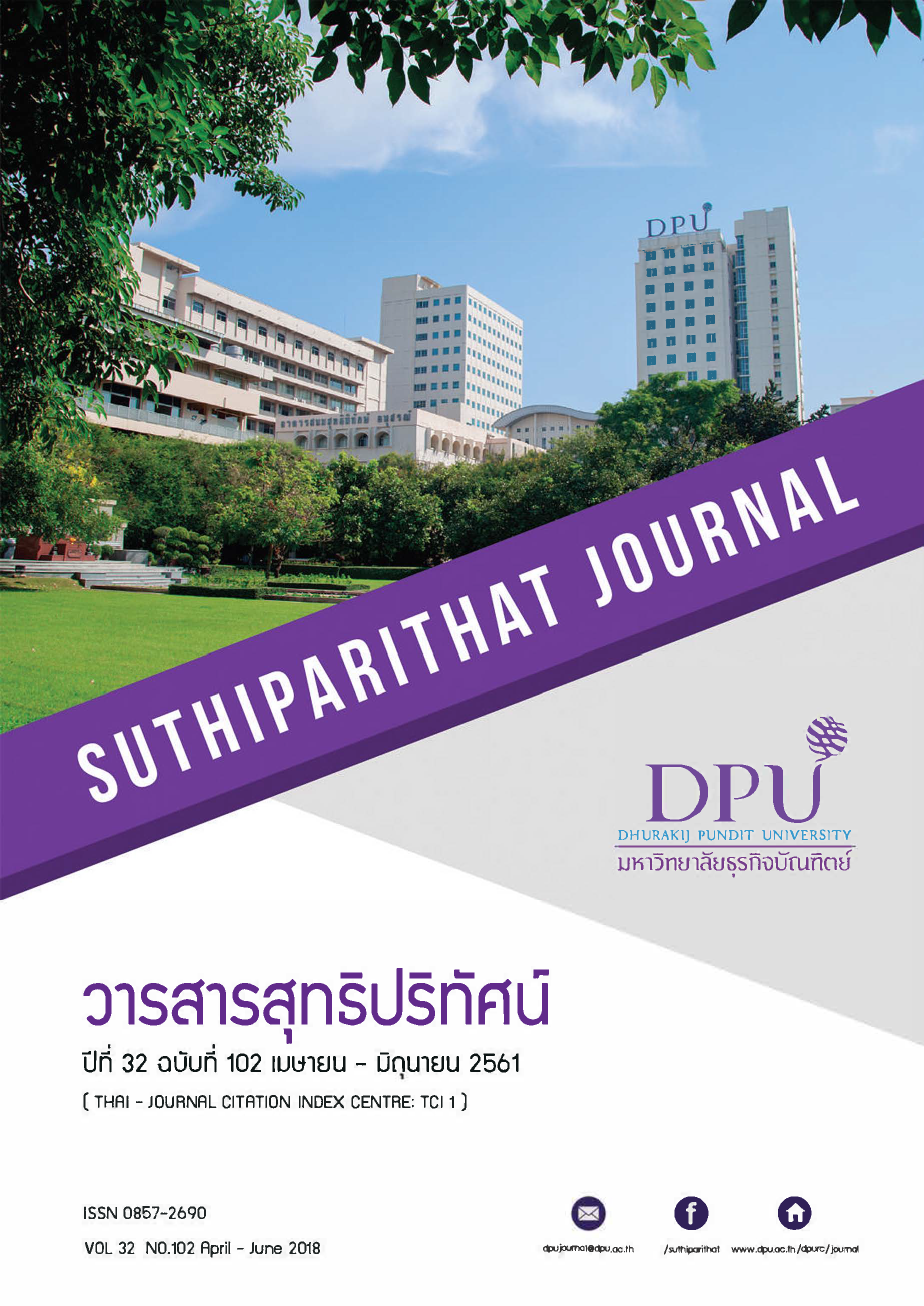แบบจำลองประเมินความอยู่รอดทางธุรกิจ
คำสำคัญ:
แบบจำลองและความอยู่รอดทางธุรกิจบทคัดย่อ
การวิจัยครั้งนี้ มีวัตถุประสงค์เพื่อพัฒนารูปแบบการวัดภาวะการล้มละลายทางธุรกิจของบริษัท เพื่อพัฒนาเครื่องมือที่ใช้ในการบริหารความเสี่ยงทางการเงินของความอยู่รอดทางธุรกิจ โดยศึกษา จากข้อมูลงบการเงินที่อยู่ในตลาดหลักทรัพย์แห่งประเทศไทย ในช่วงปี 2555-2558 ของบริษัทที่ไม่มี ปัญหาทางการเงินหรือความอยู่รอดทางธุรกิจ จำนวน 95 บริษัท และบริษัทที่มีปัญหาทางการเงินหรือ ความอยู่รอดทางธุรกิจจำนวน28 บริษัท โดยใช้เทคนิคทางสถิติแบบการวิเคราะห์การถดถอยโลจิสติก (Logistic Regression) โดยพัฒนาตัวแบบเพิ่มเติม ที่อาศัยข้อมูลจากอัตราส่วนทางการเงินของกระแส เงินสดที่เกิดจากกิจกรรมดำเนินงาน ผลการวิจัยพบว่าประสิทธิภาพของสมการถดถอยโลจิสติกที่ใช้ทำนายบริษัทที่ไม่ล้มเหลว ทางการเงินของบริษัทจดทะเบียนในตลาดหลักทรัพย์ ได้ถูกต้องร้อยละ 89.50 และทำนายบริษัทที่ ล้มเหลวทางการเงินของบริษัทจดทะเบียนในตลาดหลักทรัพย์ ได้ถูกต้องร้อยละ 72.10 และโดยเฉลี่ย แล้วสมการถดถอยโลจิสติก สามารถทำนายโดยรวมได้ร้อยละ 76.40
เอกสารอ้างอิง
กัลยา วาณิชย์บัญชา. (2551). การวิเคราะห์สถิติขั้นสูงด้วย SPSS for Windows. (พิมพ์ครั้งที่ 6). กรุงเทพฯ: โรงพิมพ์จุฬาลงกรณ์มหาวิทยาลัย.
Altman, E. I. and Lavallee, M. (1981). Business Failure Classification in Canada. Journal of Business Administration, Summer, 147 – 164.
Altman, E. I. (2002). Bankruptcy, Credit Risk, and High Yield Junk Bonds. UK: Blackwell Publishers, Ltd.
Beaver, W. (1966). Financial Ratio as Predictors of Failure. Journal of Accounting Research, 4, 71 – 127.
Begley, J., Ming, J., & Watts, S. (1996). Bankruptcy Classification Errors in The 1980s: An Empirical Analysis of Altman’s and Ohlson’s Models. Review of Accounting Studies, 1(4), 267-284
Chistine, V. Z. (1985). Assessing the Vulnerability to Failure of American Industrial Firms: A Logistic Analysis. Journal of Business Finance & Accounting, 12(1), 19-45
Gerantonis N., Vergos K., Christopoulos A. (2009). Can Altman Z-score Models Predict Business Failures in Greece?. In (Ed) Frangos C. 2nd International Conference Quantitative and Qualitative Methodologies in the Economic and Administrative Sciences, TEI of Athens, 149-154
Grice, J. S. & Dugan, M. T. (2003). Re-estimations of the Zmijewski and Ohlson bankruptcy prediction models. Advances in Accounting, 20, 77–93
Hair, J., Black, W., Babin, B., Anderson, R., & Tatham, R. (2006). Multivariate data analysis (6thed.). Uppersaddle River, N.J.: Pearson Prentice Hall.
Joseph, F. H., William, C. B., Barry, J. B., & Rolph, E. A. (2010). Multivariate Data Analysis. New Jersey: Pearson Education.
Mossman, C. E., Bell, G. G., Swartz, L. M., & Turtle, H. (1998). An empirical comparison of bankruptcy models. Financial Review, (May), 35-53.
Ohlson, J. A. (1980). Financial Ratio and the Probabilistic Prediction of Bankruptcy. Journal of Accounting Research Spring, 109 – 131.
Samarakoon, L. P., & Hasan, T. (2003). Altman’s Z-Score Models of Predicting Corporate Distress: Evidence from the Emerging Sri Lankan Stock Market. Journal of the Academy of Finance, 1, 119- 125.
Sayari, Naz & FN Can Simga Mugan. (2013).Cash Flow Statement as an Evidence for Financial Distress. Universal Journal of Accounting and Finance, 1, 95 - 102. doi:10.13189/ujaf.2013.010302.
Shumway, T. (2001). Forecasting Bankruptcy More Accurately: A Simple Hazard Model. Journal of Business, 74(1), 101 – 124.
Zmijewski, M. E. (1984). Methodological Issues Related to the Estimation of Financial Distress Models Journal of Accounting Research, 22, 59 – 82.
ดาวน์โหลด
เผยแพร่แล้ว
รูปแบบการอ้างอิง
ฉบับ
ประเภทบทความ
สัญญาอนุญาต
เนื้อหาและข้อมูลในบทความที่ลงตีพิมพ์ในวารสารสุทธิปริทัศน์ ถือเป็นข้อคิดเห็นและความรับผิดชอบของผู้เขียนบทความโดยตรงซึ่งกองบรรณาธิการวารสาร ไม่จำเป็นต้องเห็นด้วย หรือร่วมรับผิดชอบใด ๆ
บทความ ข้อมูล เนื้อหา รูปภาพ ฯลฯ ที่ได้รับการตีพิมพ์ในวารสารสุทธิปริทัศน์ ถือเป็นลิขสิทธิ์ของวารสารสุทธิปริทัศน์หากบุคคลหรือหน่วยงานใดต้องการนำทั้งหมดหรือส่วนหนึ่งส่วนใดไปเผยแพร่ต่อหรือเพื่อกระทำการใด ๆ จะต้องได้รับอนุญาตเป็นลายลักษณ์อักษรจากวารสารสุทธิปริทัศน์ก่อนเท่านั้น







